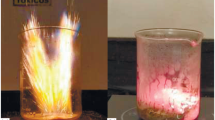Abstract
The thermal behavior of the yttria-stabilized zirconia (YSZ) and nickel oxide (YSZ–NiO) composite mixtures with the addition of graphite, multiwall carbon nanotubes and functionalized multiwall carbon nanotubes was studied. The YSZ–NiO composite is the precursor of the YSZ–Ni anode of solid oxide fuel cells. The anode exhibits a porous structure, which is usually obtained by the addition of carbon containing pore formers. Thermal analysis and X-ray diffraction evidenced that the properties of carbonaceous materials (C) and atmosphere have a strong influence on the thermal evolution of the reactions taking place upon heating the anode precursor. The dependence of both the carbon content and the chemical nature of the ceramic matrix on the thermal behavior of the composite were investigated. The discussed results evidenced important features for optimized processing of the anode.





Similar content being viewed by others
References
Minh NQ. Ceramic fuel cells. J Am Ceram Soc. 1993;76:563–88.
Muccillo R, Muccillo ENS, Fonseca FC, de Florio DZ. Characteristics and performance of electrolyte-supported solid oxide fuel cells under ethanol and hydrogen. J Electrochem Soc. 2008;155:B232–35.
de Florio DZ, Varela JA, Fonseca FC, Muccillo ENS, Muccillo R. Direcionamentos da tecnologia industrial de células a combustível de óxidos sólidos. Quim Nova. 2007;30:1339–46.
Singhal CS. Advances in solid oxide fuel cell technology. Solid State Ionics. 2000;135:305–13.
Trigueiro JPC, Silva GG, Lavall RL, Furtado CA, Oliveira S, Ferlauto AS, et al. Purity evaluation of carbon nanotube materials by thermogravimetric, TEM, and SEM methods. J Nanosci Nanotechnol. 2007;7:3477–86.
Li H, Zhao N, He C, Shi C, Du X, Li J. Thermogravimetric analysis and TEM characterization of the oxidation and defect sites of carbon nanotubes synthesized by CVD of methane. Mater Sci Eng. 2008;473:355–9.
Blachnio M, Staszczuk P, Grodzicka G. Adsorption and porosity properties of pure and modified carbon nanotube surface. J Therm Anal Calorim. 2008;94:641–8.
L′vov BV. Mechanism of carbothermal reduction of iron, cobalt, nickel and copper oxides. Thermochim Acta. 2000;360:109–20.
Richardson FD, Jeffes JE. The thermodynamics of substance of interest in iron and steelmaking from 0 to 2400 °C. I. Oxides. J Iron Steel Inst. 1948;160:261–70.
Acknowledgements
Authors are thankful to CNEN, CNPq (554970/2006-6, 555173/2005-4), and FINEP. Carbon nanotubes were produced at the Laboratório de Nanomaterias in the Physics Department of UFMG.
Author information
Authors and Affiliations
Corresponding author
Rights and permissions
About this article
Cite this article
Arico, E., Tabuti, F., Fonseca, F.C. et al. Carbothermal reduction of the YSZ–NiO solid oxide fuel cell anode precursor by carbon-based materials. J Therm Anal Calorim 97, 157–161 (2009). https://doi.org/10.1007/s10973-009-0248-4
Published:
Issue Date:
DOI: https://doi.org/10.1007/s10973-009-0248-4




